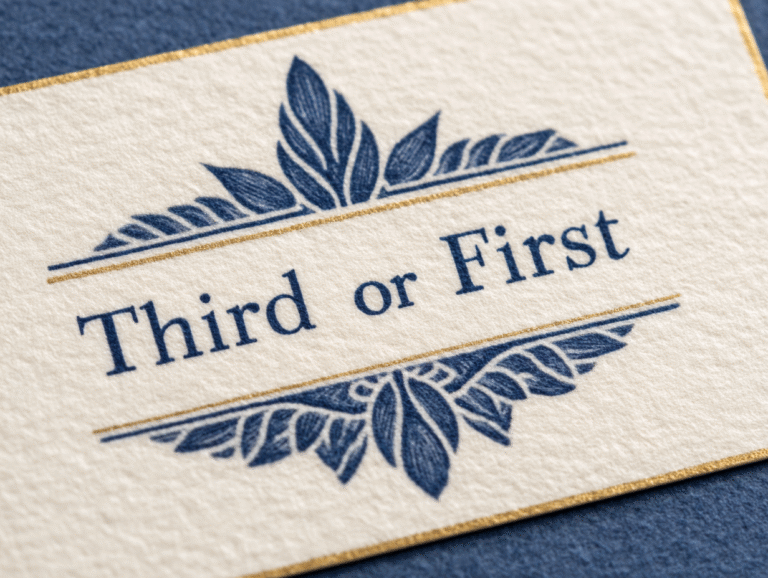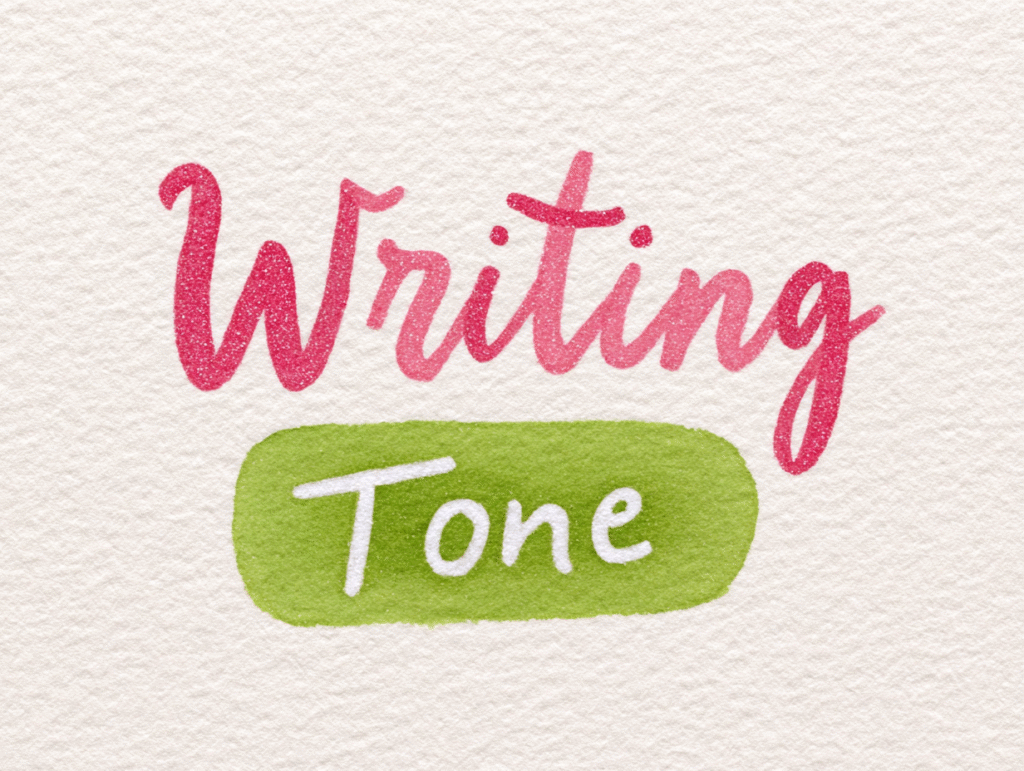First Person vs. Third Person: Choosing the Right Perspective for Your Writing
One of the earliest choices a writer makes is if they should write in the first person or third person. It might seem like a stylistic choice at first, but it actually it affects the tone, depth, structure, and emotional impact of your writing.
Same goes for writing fiction and it does for writing marketing copy, academic essays, or non-fiction. The narrative perspective you choose can either draw readers closer or it can keep them at arm’s length. It shapes how they feel and how they interpret what you’re saying.
What Is First Person?
Well firstly.. first person writing uses the pronouns I, me, my, we, and our. Making the narrator a character in the story and it’s often the main one, or could even be the author themselves.
First person creates intimacy as readers will see the world through the narrator’s eyes, and gets to think their thoughts, and feel their emotions making it immediate and personal.
Example:
I couldn’t believe my luck when the last train pulled away just as I reached the platform. I stood there in the drizzle, watching the lights disappear.
We know exactly how this person feels and we’re not just told they missed a train, we’re shown their disappointment.
What Is Third Person?
So, third person uses he, she, they, them, his, her, and character names. The narrator is not a character in the story this time, but just an outside observer, therefore this perspective allows the writer to describe events more broadly.
There are two common types:
- Third Person Limited: Focuses on one character’s thoughts and experiences.
- Third Person Omniscient: The narrator knows literally everything about every single character, all the events that happen, and the background stories of everything and everyone.
Example (Limited):
Tom watched the train disappear into the distance. He didn’t move. There was no point now.
Example (Omniscient):
Tom watched the train disappear, unaware that Anna was still inside, frantically waving from the last carriage window.
Third person gives the writer a lot of flexibility. You can show multiple characters’ experiences of the same event from different perspectives, provide context you can’t in first person. You can zoom out to give the bigger picture, like you’re an invisible ghost floating above the story with the ability to travel any where and to any time.

For Fiction Writers: Depth vs. Distance
First and third person each bring their unique strengths to fiction.
First Person in Fiction
This perspective does really well in character-driven stories as it lets readers feel super close to the protagonist, almost as if they’re actually reading their diary. This is really good for psychological thrillers, coming-of-age stories, or novels centred around things like personal growth.
Example:
I’d always thought courage was something loud. Mine turned out to be silent. I picked up the phone, heart racing, and dialled.
This inner monologue wouldn’t hit quite as hard in third person where you wouldn’t get to feel the character’s vulnerability because you’re not inside their head.
But on a further note… first person can actually be limiting as the reader only knows what the narrator knows and so if you need to reveal a twist then you have to do it naturally as you can’t simply cut to another character’s thoughts…
Tip: If you’re going with first person then make sure your narrator is interesting as a dull narrator can turn readers off very quickly.
Third Person in Fiction
Third person is often used in genre fiction such as fantasy, historical, or mystery novels, where multiple storylines or perspectives are needed to convey the story at its best.
Example:
Elena paused at the mouth of the alley. Across the city, James was already running. Neither knew the other was in danger.
This allows the writer to build tension through dramatic irony as the reader is privy to information that the characters are unaware of.
Third person also makes world-building a lot easier. You can describe cities, history, customs, and action without having to filter all the little bits of trivia through a single character’s understanding.
Tip: Third person limited can give you intimacy while maintaining control of the narrative and it’s a good middle ground if you want character insight without the restrictions of first person.
For Marketers: Building Trust or Authority
In marketing, tone is everything, so whether you use first or third person affects how your audience connects with your message.
First Person in Marketing
First person writing feels warm, relatable, and trustworthy and so it’s ideal for personal brands, founder stories, and direct customer communication.
Example:
I started Maple & Moon Candles because I wanted better scents for my own home. Now, I’m proud to share them with yours.
This sounds like a regular conversation with a shop owner. Therefore it creates that emotional connection with the buyer and at the same time positions the seller as authentic and approachable.
Use first person for:
- Email newsletters
- Brand storytelling
- Testimonials
- Behind-the-scenes content
Tip: Keep the voice consistent though, for example if your landing page says “we,” your social media shouldn’t suddenly switch to “they” when referring to the brand. Also remember to keep it consistent between using “I” and “we”.
Third Person in Marketing
Third person gives your business a more formal and established tone, suggesting professionalism. This is particularly useful for B2B communication, corporate websites, or press releases.
Example:
Founded in 2016, Maple & Moon is an independent candle company known for sustainable production and unique scent profiles.
There’s a sense of authority here. It of course sounds less personal but its more polished.
Use third person for:
- Product descriptions
- Case studies
- Press releases
- White papers
Tip: If your brand isn’t centred around a specific personality, third person may feel more suitable. Just be careful not to come across as stiff or overly corporate.

For Students: Voice vs. Objectivity
For students, the choice of perspective is often dictated by the type of writing and the expectations of your institution.
First Person in Academic Writing
Traditionally, academic writing actually discouraged the use of first person but now a days that’s changing slightly, especially in reflective essays, personal statements, or qualitative research.
Example:
In my experience as a student researcher, I found that participant responses were shaped by tone and context.
Used carefully first person can clarify the writer’s role without sounding self-indulgent.
Third Person in Academic Writing
Third person remains the standard for essays, reports, and research papers as it provides a neutral tone that focuses on evidence rather than opinion, which is a no no.
Example:
The data suggests a strong correlation between sleep patterns and academic performance.
This approach puts the emphasis on the findings and not the writer, its the data that’s important here!
Tip: However always check the guidelines as some instructors now welcome a limited use of first person, while others still prefer a more traditional, objective voice.

For Non-Fiction Writers: Insight vs. Authority
Non-fiction is a wide field. so your perspective will really depend on the subject matter and your relationship to it.
First Person in Non-Fiction
Memoirs, travel writing, and narrative non-fiction often use first person to draw readers in, as it allows for storytelling, emotion, and reflection.
Example:
When I arrived in the Andes, I thought I was prepared. What I hadn’t anticipated was the silence. It was heavy, sacred, and unlike anything I’d ever known.
This kind of writing builds trust as readers feel like you’re letting them in on something personal, like you’ve been there, you’ve experienced it, your trip to the Andes was real, so your report must be too.
Use first person for:
- Memoirs
- Travel writing
- Opinion pieces
- Self-help or personal development (especially when sharing lived experience)
Tip: First person works best when you’re offering something specific and sincere. Avoid using it just to fill space or rant.
Third Person in Non-Fiction
Third person is common in journalistic writing, academic non-fiction, biographies, and textbooks. It creates distance and a sense of objectivity.
Example:
In 1953, Edmund Hillary and Tenzing Norgay became the first confirmed climbers to reach the summit of Mount Everest.
This approach is ideal for presenting facts, analysis, or multiple perspectives.
Tip: You can mix both. Many non-fiction books these days start with a personal story and then shift into research or commentary written in third person.
Hybrid Approaches: Mixing First and Third
Some writing benefits from switching between perspectives. However make sure to do this carefully to avoid confusing the reader.
In Fiction:
You might use third person for most of the book and then switch to first person for things like diary entries, letters, things like that.
In Non-Fiction:
A self-help book might begin with a personal anecdote in first person, followed by research and commentary in third.
In Marketing:
A “Meet the Founder” page might be written in first person, while product descriptions remain in third.
Whatever you choose, keep it consistent within sections or chapters so the tone doesn’t jar.

Final Thoughts: Choosing What’s Right for You
In conclusion there’s no universal rule for which perspective is best and what matters is which one serves your story or message most effectively.
Here’s a quick reference for you:
| Purpose | First Person | Third Person |
|---|---|---|
| Fiction (intimate, character-driven) | ✔️ | ✔️ |
| Fiction (epic, multi-character) | ✖️ | ✔️ |
| Marketing (personal connection) | ✔️ | ✖️ |
| Marketing (professional tone) | ✖️ | ✔️ |
| Academic Essays | Occasionally | ✔️ |
| Memoirs / Personal Non-Fiction | ✔️ | ✖️ |
| Historical / Journalistic Non-Fiction | ✖️ | ✔️ |
Why not try writing a scene or paragraph in both styles and often the right voice will just emerge naturally before you. Let the material guide you, not the other way round.
Perspective is more than a technical decision… it’s a tool that helps shape meaning, tone, and trust!






